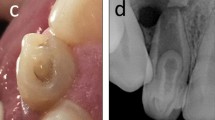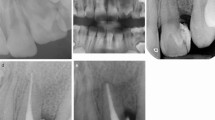Abstract
Dens invaginatus (DI) is a developmental anomaly resulting in a deepening or invagination of the enamel organ into the dental papilla prior to calcification of the dental tissues. Presence of DI is considered to increase the risk of caries and pulpal pathology, but they are often missed in the initial orthodontic assessment as they present with no clinical signs of an anomaly. In absence of adequate oral hygiene and maintenance, bacterial contamination of these malformations can lead to the development of early caries and consequent pulpal death. Early diagnosis of these lesions is critical as they can negatively impact any planned orthodontic treatment and assessment of the prognosis of these lesions is therefore necessary prior to the commencement of orthodontic treatment. In this article, we aim to illustrate the need for appropriate diagnosis and multidisciplinary approach in the management of DI in patients undergoing orthodontic treatment.
Key points
-
Dens invaginatus is often missed in the initial orthodontic assessment as it presents with no clinical signs.
-
Orthodontic patients should be routinely checked for dens invaginatus on upper lateral incisors prior to commencement of treatment.
-
Early diagnosis and conservative management of dens invaginatus could avoid mid-treatment complications, delay in orthodontic treatment and facilitate better prognosis.
This is a preview of subscription content, access via your institution
Access options
Subscribe to this journal
Receive 24 print issues and online access
$259.00 per year
only $10.79 per issue
Buy this article
- Purchase on Springer Link
- Instant access to full article PDF
Prices may be subject to local taxes which are calculated during checkout










Similar content being viewed by others
References
Hulsmann M. Dens invaginatus: aetiology, classification, prevalence, diagnosis, and treatment considerations. Int Endod J 1997; 30: 79-90.
Gallacher A, Ali R, Bhakta S. Dens invaginatus: diagnosis and management strategies. Br Dent J 2016; 221: 383-387.
Grahnen H L B, Omnell K. Dens invaginatus. I. A clinical, roentgenological and genetical study of permanent upper lateral incisors. Odontol Revy 1959; 10: 115-137.
Kettunen P, Laurikkala J, Itäranta P, Vainio S, Itoh N, Thesleff I. Associations of FGF-3 and FGF-10 with signalling networks regulating tooth morphogenesis. Dev Dyn 2000; 219: 322-332.
Burton D J, Saffos R O, Scheffer R B. Multiple bilateral dens in dente as a factor in the aetiology of multiple periapical lesions. Oral Surg Oral Med Oral Pathol 1980; 49: 496-499.
MA R. A collection of dilated composite odontomas. Br Dent J 1937; 63: 65-85.
Thongudomporn U, Freer T J. Anomalous dental morphology and root resorption during orthodontic treatment: a pilot study. Aust Orthod J 1998; 15: 162-167.
Hamasha A A, Alomari Q D. Prevalence of dens invaginatus in Jordanian adults. Int Endod J 2004; 37: 307-310.
Miyoshi S F J, Nakata T, Yamamoto K, Deguchi K. Dens invaginatus in Japanese incisors. Jap J Oral Biol 1971; 13: 539-544.
Oehlers F A. Dens invaginatus (dilated composite odontome). II. Associated posterior crown forms and pathogenesis. Oral Surg Oral Med Oral Pathol 1957; 10: 1302-1316.
Kjaer I. Morphological characteristics of dentitions developing excessive root resorption during orthodontic treatment. Eur J Orthod 1995; 17: 25-34.
Pradeep K, Charlie M, Kuttappa M A, Rao P K. Conservative Management of Type III Dens in Dente Using Cone Beam Computed Tomography. J Clin Imaging Sci 2012; 2: 51.
Kfir A, Telishevsky-Strauss Y, Leitner A, Metzger Z. The diagnosis and conservative treatment of a complex type 3 dens invaginatus using cone beam computed tomography (CBCT) and 3D plastic models. Int Endod J 2013; 46: 275-288.
Lejri W, Ines K, Marwen O, Douki N. Diagnostic and therapeutic approach in dens in dente. Endodontology 2016; 28: 192.
Thongudomporn U, Freer T J. Prevalence of dental anomalies in orthodontic patients. Aust Dent J 1998; 43: 395-398.
Mavragani M, Apisariyakul J, Brudvik P, Selvig K A. Is mild dental invagination a risk factor for apical root resorption in orthodontic patients? Eur J Orthod 2006; 28: 307-312.
Author information
Authors and Affiliations
Corresponding author
Rights and permissions
About this article
Cite this article
Chaturvedula, B., Muthukrishnan, A., Bhuvaraghan, A. et al. Dens invaginatus: a review and orthodontic implications. Br Dent J 230, 345–350 (2021). https://doi.org/10.1038/s41415-021-2721-9
Received:
Accepted:
Published:
Issue Date:
DOI: https://doi.org/10.1038/s41415-021-2721-9



